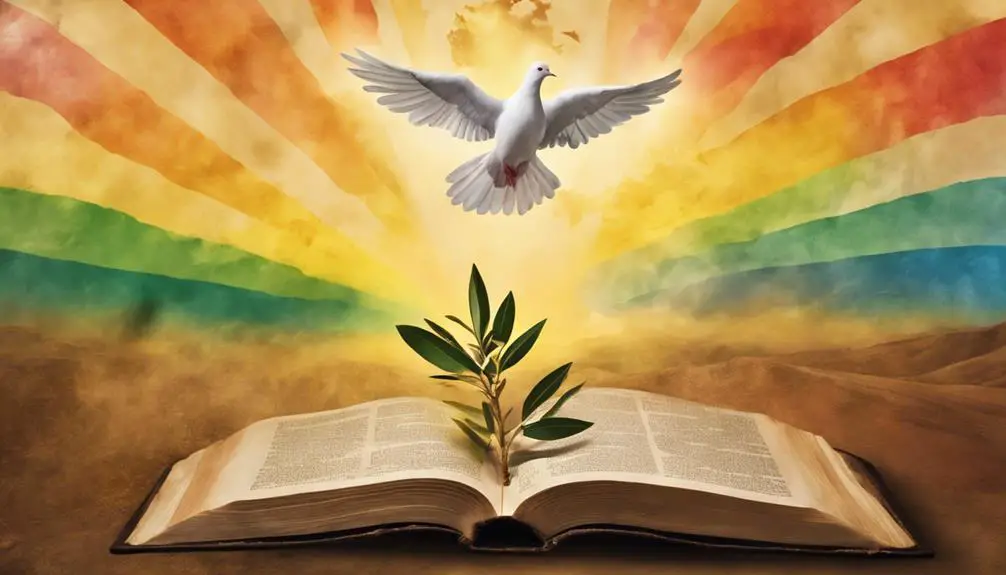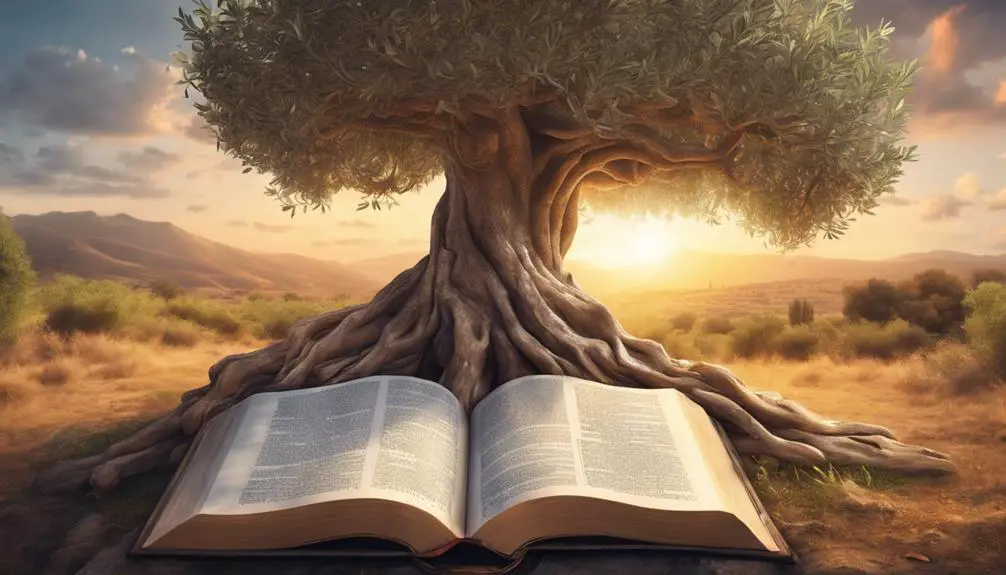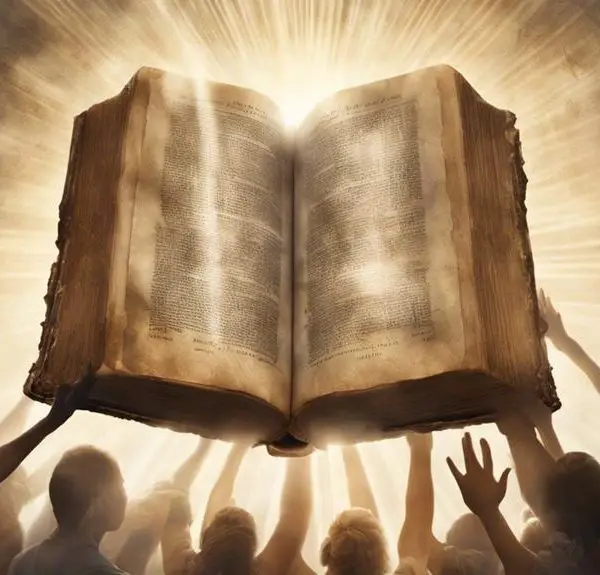Yearn to decipher the fascinating motifs like light, darkness, water, and numbers in the Bible? Dive in to uncover their unique symbolism!

Motifs in the Bible
Did you know that the motif of 'light and darkness' appears over 100 times in the Bible? It's a fascinating theme, often symbolizing the battle between good and evil.
You'll find that the Bible is rich with motifs like this, such as water, numbers, and journeys, each carrying its own unique symbolism.
Want to know more about how these motifs contribute to the Bible's overall message? There's plenty more to uncover.
Key Takeaways
- The Bible frequently uses motifs such as 'light and darkness' and 'water' to symbolize the struggle between good and evil, and spiritual cleansing respectively.
- Numerical symbolism in the Bible, like the number seven and forty, reveal deeper spiritual meanings and periods of testing.
- The motif of 'wilderness' represents divine encounters, trials, and spiritual growth, often paralleling physical journeys with spiritual transformations.
- The 'Tree of Life' serves as a potent symbol for immortality, divine wisdom, and spiritual nourishment in biblical narratives.
The Symbolism of Light and Darkness

Delving into the symbolism of light and darkness in the Bible, you'll quickly uncover a rich tapestry of motifs, each illuminating a profound aspect of human experience and divine truth. The contrast between light and darkness forms the backbone of many a biblical narrative, often used to represent good and evil, knowledge and ignorance, respectively.
In Genesis, the act of divine creation itself is marked by the separation of light from darkness, a vivid demonstration of divine illumination symbolism. Here, light is a potent symbol of God's benevolent power, his ability to bring clarity, order and life into the void of darkness.
There's also an intriguing contrast between light and darkness within the New Testament, particularly in the Gospel of John. Christ is often referred to as the 'light of the world', a beacon of divine truth in a world shrouded in spiritual darkness. This stark contrast serves to emphasize the transformative power of divine illumination, the capacity of God's light to dispel darkness, ignorance, and sin.
Water as a Recurring Motif

Moving beyond the duality of light and darkness, you'll notice water emerging as another recurring motif in the Bible, profoundly embedded in both the Old and New Testaments. It's a symbol with a dual nature, embodying both life and destruction. But most notably, you'll find water's purifying role in several instances, hinting at the idea of spiritual cleansing and renewal.
Take baptism, for example, where water signifies the washing away of sins and the start of a new spiritual life. This purification theme is echoed in the Old Testament too, such as in the ritualistic cleansing practices of the Israelites.
Now, let's consider Biblical flood symbolism. The flood narrative in Genesis is a vivid illustration of water's destructive power, where it's employed by God as a tool for divine judgement and a reset of humanity's moral compass. But even in this cataclysmic event, the waters recede, making way for a fresh start, embodying hope and regeneration.
The Significance of Numbers

Turning our attention to the realm of numerology, you'll uncover that the Bible frequently employs numbers as potent symbols, each carrying its own distinct spiritual significance. For instance, the number seven, viewed as the number of divine perfection and completeness, often appears in contexts implying a sense of wholeness. It's seen in the seven days of creation, the seven seals in Revelation, and the command to forgive seventy times seven times.
Numerological interpretations go beyond mere appearances. Biblical arithmetic, the study of numbers within the scriptures, reveals a deeper layer of meaning. Take the number forty, which frequently signifies periods of testing or judgement. It surfaces in the forty days of rain Noah endured, the forty years the Israelites wandered in the wilderness, and Jesus' forty days of temptation in the desert.
These aren't coincidences, but rather a precise, purposeful use of numbers to convey deeper spiritual truths. You'll find that by understanding the symbolic significance of numbers, you can gain a richer, more profound interpretation of biblical texts, enhancing your comprehension of the spiritual principles they convey.
Motifs of Wilderness and Journeys

In the rich tapestry of biblical narratives, you'll notice that the motifs of wilderness and journeys hold a pivotal role, often serving as metaphors for spiritual transformation and personal growth. Wilderness symbolism is prominent, often representing a place of divine encounter, trial, and spiritual growth. Think of Moses in the desert, or Jesus's 40-day fast in the wilderness. They're not just geographical locations, but spaces for forging character and faith.
The motif of journeys, too, carries significant weight. Journey interpretations in biblical narratives often depict a physical movement that parallels a spiritual journey. Abraham's journey from Ur to Canaan signifies his transition from polytheism to monotheism. It's not merely about the physical distance covered, but the spiritual progress made.
These motifs aren't accidental. They're used purposefully and strategically to convey profound truths about the human experience and spiritual evolution. So, when you read these narratives, don't just see them as historical records. Look deeper, notice the wilderness symbolism and journey interpretations, and reflect on the spiritual insights they offer. They're more than just stories – they're metaphors that invite you on your own spiritual journey.
The Tree of Life Motif

Diving into another recurring motif in biblical literature, you'll encounter the profound symbolism of the Tree of Life. The Tree's metaphoric role is multifaceted, embodying concepts of immortality, divine wisdom, and spiritual nourishment. Its branches, for instance, represent different aspects of divine wisdom, while its roots symbolize the anchoring of the soul in spiritual truth.
The Tree of Life isn't only an emblem of life's continuity, but also serves as a stark reminder of mankind's lost innocence and the eternal life that was once within reach. Its fruits, offering the promise of eternal life, were denied to Adam and Eve after their transgression, symbolizing humanity's fall from grace.
Life's symbolic representation in this motif is nuanced and complex. It's not merely about biological existence, but rather, a life infused with divine vitality and spiritual fulfillment. The Tree of Life motif inspires contemplation on the nature of existence, the pursuit of wisdom, and the yearning for a transcendent spiritual life. It's a potent reminder of the spiritual bounty that awaits those who strive for divine wisdom and the reclamation of lost innocence.
Frequently Asked Questions
How Are Motifs Used to Enhance Storytelling in the Bible?
You're exploring how motifs enhance storytelling. Consider the symbolism of numbers, often used to convey deeper meaning. For instance, the number 40 symbolizes testing or judgment.
Biblical landscape motifs also play a role. The desert, for instance, often represents isolation or testing. Through these motifs, you can see layers of meaning woven into the narrative, adding depth and complexity to the stories.
They're not just details, they're significant components of the storytelling framework.
Can You Explain the Role of Animals as Motifs in Biblical Narratives?
Sure, you often see animals as motifs in biblical narratives. They're not just there for decoration; they've a deeper meaning. This is where animal symbolism interpretation comes into play.
In the biblical zoology context, animals often represent certain qualities, behaviors, or symbols. For instance, a lion might symbolize courage, while a lamb could represent innocence.
It's a fascinating way to add layers to a story.
How Are Different Colors Used as Motifs in the Bible and What Do They Symbolize?
In understanding color symbolism in Christian art and its cultural influence on biblical color interpretation, you'll find colors play a crucial role.
For instance, blue often represents heaven or divinity, red signifies sacrifice or passion, white symbolizes purity or righteousness, and black can denote sin or death.
These color motifs help convey deeper meanings and messages, providing layers of interpretation to biblical narratives.
Are There Any Recurrent Motifs Associated With Specific Biblical Characters?
Yes, there are recurrent motifs linked to specific biblical characters. For instance, the 'Symbolism of Numbers' is evident with Moses and the number 40, signifying testing or judgment.
In the case of Daniel, 'Motifs in Prophecies' are prevalent, as many of his visions predict future events. These motifs not only enhance narrative depth but also contribute to the symbolic structure of biblical text.
What Are Some Motifs Used in the Bible to Represent Divine Intervention or Miracles?
You're exploring divine intervention symbolism and miraculous motifs in ancient texts. Burning bushes, parting seas, and healing the sick are used extensively as symbols of divine intervention.
These motifs aren't random; they're chosen to emphasize the miraculous nature of these events, showing a higher power at work.
It's not just about the miracle itself, but the profound impact and transformation it brings, underlining the divine's active role in human affairs.
Conclusion
In conclusion, you've seen how the Bible uses motifs like light, darkness, water, numbers, wilderness, journeys, and the Tree of Life to convey profound truths. These aren't mere artistic flourishes, but deep-seated symbols that carry weighty spiritual significance.
Understanding these motifs doesn't just enrich your reading of the Bible, it deepens your grasp of its timeless truths. So, next time you delve into its pages, keep an eye out for these recurring themes.



Sign up